[nextpage title=”Introduction”]
We disassembled a DVD burner to show you the main components you will find on an optical drive, like CD and DVD readers and burners. In this tutorial we will not only show all main components from an optical drive, but also teach you how disassemble an optical unit as well.
Contrary to hard disk drives, you can open optical units, but you cannot turn it on while it is open. The laser beam generated by the optical pickup unit is invisible and you can go blind if you look at it. Since it is invisible, you can’t have any clue where it is and if you are looking at it or not!
Before opening our DVD burner to show you how it looks like inside, let’s take a look at its connectors (see Figure 1).
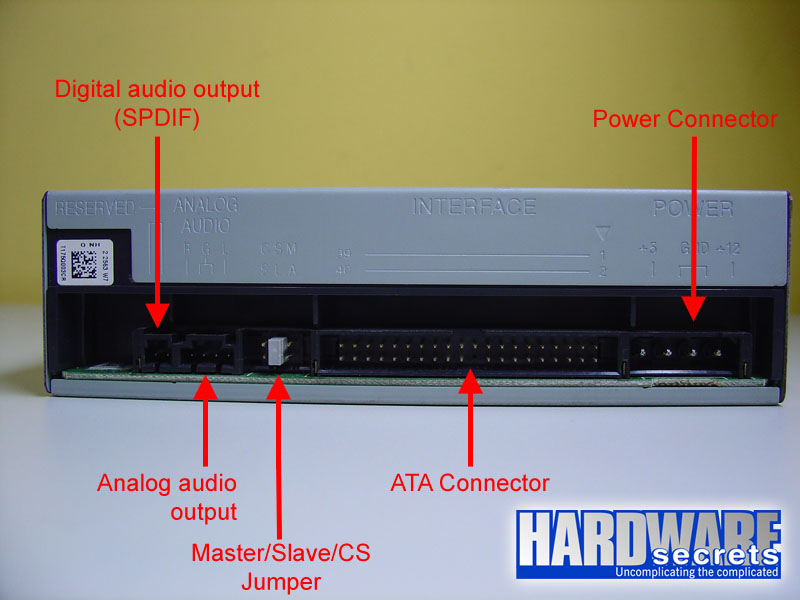 Figure 1: Connectors found on a typical optical unit.
Figure 1: Connectors found on a typical optical unit.
Optical units have basically three connectors, one for power, one for exchanging data with the computer and one audio output (also called “analog audio output”), which should be connected to your sound card (or to your motherboard, if your motherboard has on-board audio).
Optical units can also have one digital audio output, which is also known as SPDIF (Sony/Phillips Digital Interface Format). If your optical unit has this connector, go for it. Since it transmits digital audio instead of analog audio, you will get a far better sound quality from your audio CDs and DVDs if you use this connection instead of the analog one. We’ve already written a full tutorial on this subject, so you may want to take a look at it to learn more about this.
The connector used for exchange data between the optical unit and the computer is better known as “interface”. The most common interface for end-users is called ATA (Advanced Technology Attachment). There other interfaces but they are very rare nowadays: SATA (Serial ATA), which was created to replace ATA and is still entering the market; SCSI (Small Computer Systems Interface), which is targeted to servers and rarely seen on PCs targeted to end-users; and proprietary, which was seen on the very first optical units (“1x” and “2x”CD-ROM units) before the ATA standard was changed to be compatible with optical units.
The master/slave jumper on ATA optical units can be configured in three different ways:
- Master: this means that this drive will be the only one attached to the cable that connects the optical unit to the computer.
- Slave: this means that this drive will be the second drive attached to the cable that connects the optical unit to the computer.
- CS (Cable Select): this means that you will use a “special” cable (called CS cable) that the configuration of whether a drive will be master or slave will be made by the position of the unit on the cable and not by a jumper configuration on the drive.
You can mix hard disks and optical units on the same cable. However, this is not recommended due to performance issues. The best way to connect an optical unit to your computer is as single drive (as “master”) on the secondary ATA port on the motherboard, while connecting the hard disk drive alone on the primary ATA port as “master” as well, using a different cable.
Before opening the unit to show how it looks like inside, let’s talk about an old trick that will be necessary for opening the unit: the manual ejection.
[nextpage title=”Manual Ejection Mechanism”]
All optical units have a manual ejection mechanism, where you can open the drive tray even with the computer turned off or with the drive out of the PC. This is a very old trick, but we will need to use it to open our optical unit. First, locate the manual ejection hole on the front of the unit.
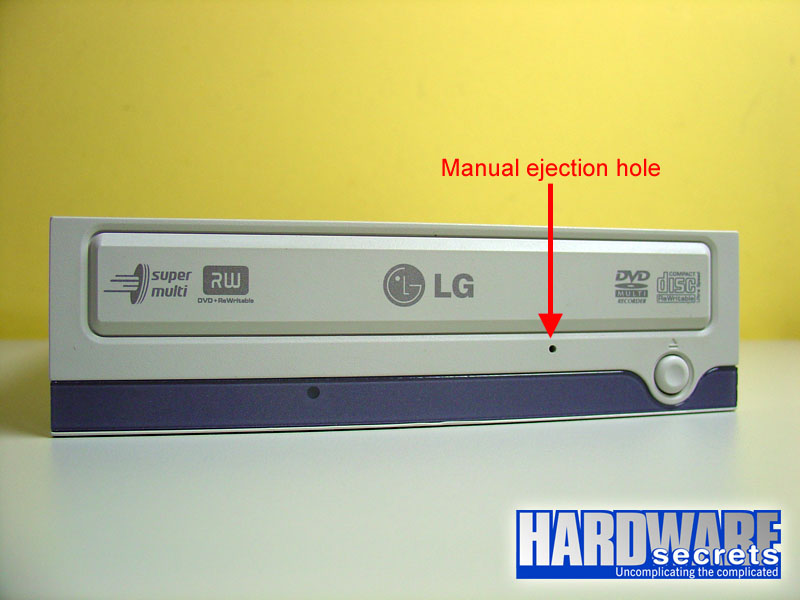 Figure 2: Manual ejection hole.
Figure 2: Manual ejection hole.
Then get a paper clip, open it and insert it in the hole, like shown in Figure 3.
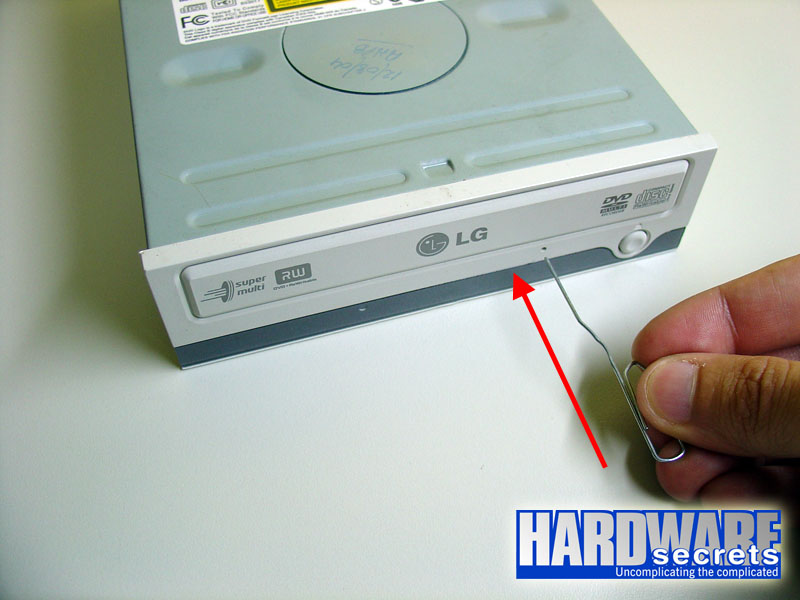 Figure 3: Inserting a paper clip in the manual ejection hole.
Figure 3: Inserting a paper clip in the manual ejection hole.
You will feel some resistance. Push it until the tray is a little bit open, as shown in Figure 4.
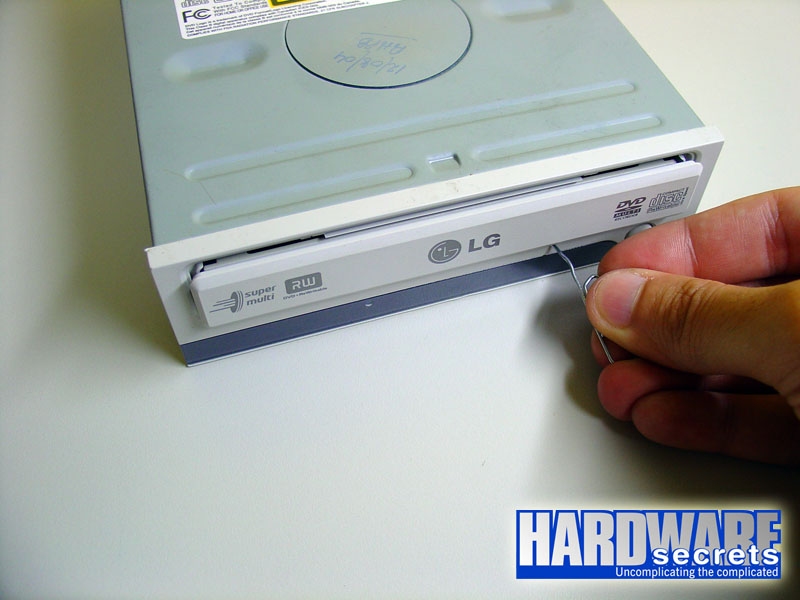 Figure 4: Tray opened thanks to our trick.
Figure 4: Tray opened thanks to our trick.
Then, just pull the tray with your hands to open it completely.
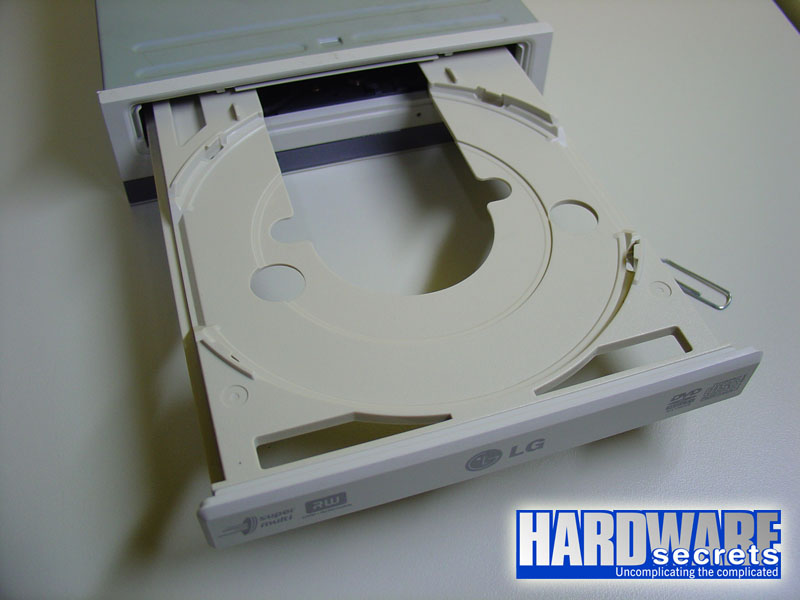 Figure 5: Tray completely opened.
Figure 5: Tray completely opened.
Now let’s open the optical unit.
[nextpage title=”Opening the Optical Unit”]
To open your optical unit you first will need to remove the tray door, where normally the manufacturer logo and several other logos and seals are printed on. Just follow the directions shown in Figure 6.
 Figure 6: How to remove the tray door.
Figure 6: How to remove the tray door.
Next, just unscrew the bottom part of the unit. This is very simple; usually it is just a matter of locating and unscrewing four Phillips screws.
 Figure 8: Locating the screws.
Figure 8: Locating the screws.
Removing the bottom metallic cover from your optical unit the first thing you will see is its logic board. You will also need to remove the top metallic cover. To do that you will need to remove the front panel. It has two locks, one on each side of the unit. Just push them with a small screwdriver as shown in Figure 9.
 Figure 9: Removing the front panel.
Figure 9: Removing the front panel.
After removing the panel, you will be able to remove the top metallic cover from your unit. Removing it you will see your unit’s mechanical parts and the optical pickup.
[nextpage title=”How to Remove the Logic Board”]
Removing the logic board is not so simple. It has several flat-cables and wires attached, so you first need to detach these cables.
The main flat cable comes from the optical pickup unit. To remove it first you have to study the mechanism used to hold this cable to its connector. On our drive this mechanism cold be released using a small screwdriver, as show on the pictures below. Pay attention because in some units this mechanism is released by moving the plastic lock forward and not upward like in our drive.
 Figure 10: Releasing the optical pickup unit flat-cable.
Figure 10: Releasing the optical pickup unit flat-cable.
 Figure 11: Releasing the optical pickup unit flat-cable.
Figure 11: Releasing the optical pickup unit flat-cable.
 Figure 12: Releasing the laser optical unit flat-cable.
Figure 12: Releasing the laser optical unit flat-cable.
 Figure 13: Flat-cable released.
Figure 13: Flat-cable released.
[nextpage title=”How to Remove the Logic Board (Cont’d)”]
Now look for the plastic hooks that are holding the logic board (see Figure 14). Press them with a small screwdriver to release the logic board. Beware when pulling the logic board. There are some flat-cables and wires below it that you still need to detach (see Figure 16).
 Figure 14: Plastic hooks that hold the logic board.
Figure 14: Plastic hooks that hold the logic board.
 Figure 15: Releasing the logic board.
Figure 15: Releasing the logic board.
 Figure 16: There are still some flat-cables and wires connected to the logic board.
Figure 16: There are still some flat-cables and wires connected to the logic board.
Carefully pull the cables with your fingers and you will be able to remove the logic board from the drive.
 Figure 17: Disconnecting the cables.
Figure 17: Disconnecting the cables.
Now you have the logic board detached from the drive. Let’s take a look at the mechanical components.
[nextpage title=”Mechanical Components”]
Now let’s explain about the main mechanical components of an optical drive. First you will find three motors: sled, which moves the optical pickup unit; spindle, which rotates the disc; and tray, which opens and closes the tray. In Figure 18 the tray covers the spindle motor. Notice that this picture and Figure 19 were taken before we removed the logic board and that’s why you can see it there.
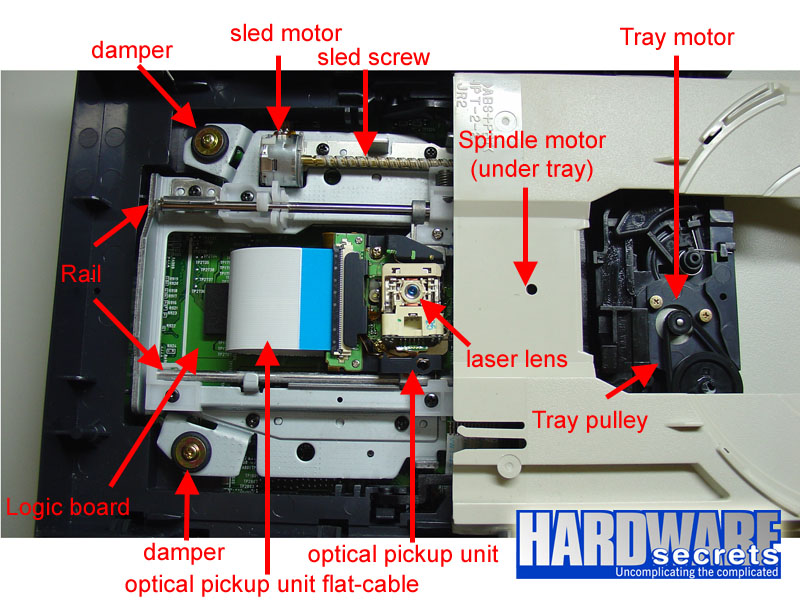 Figure 18: Main mechanical components.
Figure 18: Main mechanical components.
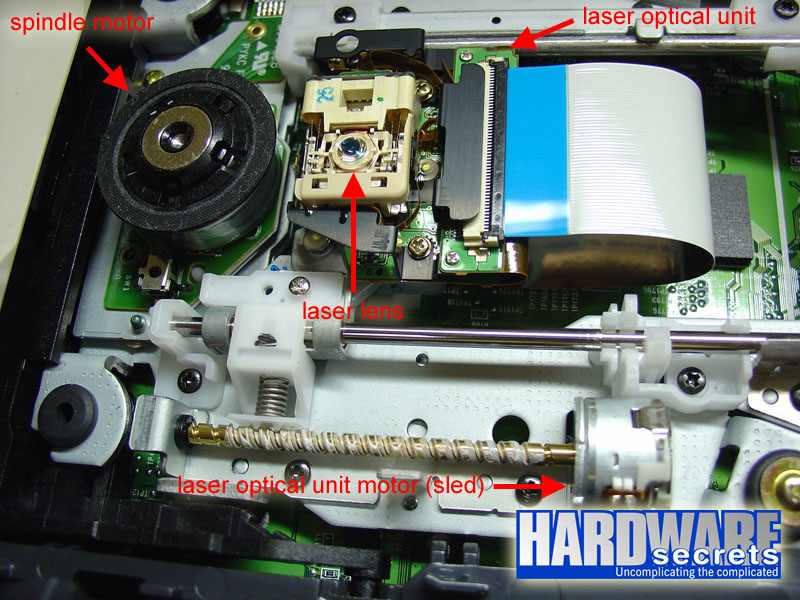 Figure 19: Main mechanical components.
Figure 19: Main mechanical components.
The tray motor can be connected to the tray by a pulley or can be directly driven, depending on the optical drive model. Our model used a pulley, as you can see in Figure 20. If the tray is not opening the first thing to check is if the tray pulley is broken or not.
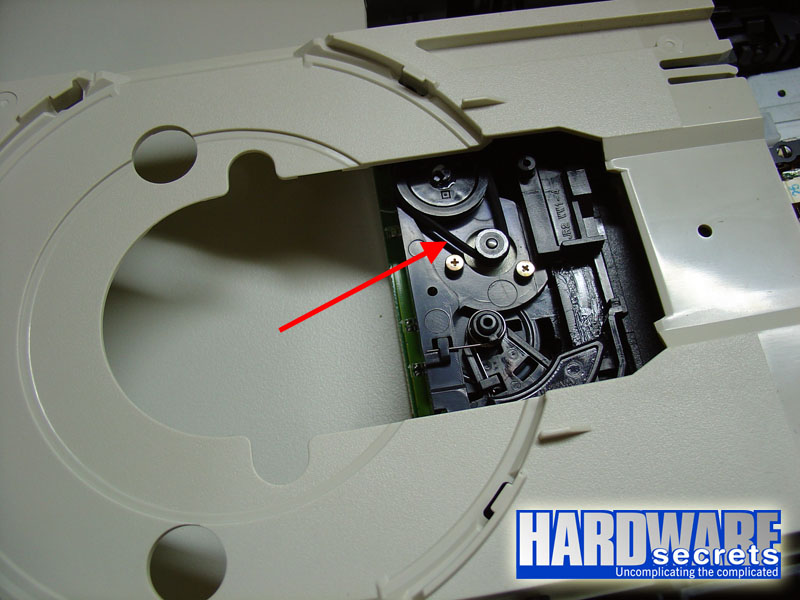 Figure 20: Tray motor. The red arrow indicated the pulley.
Figure 20: Tray motor. The red arrow indicated the pulley.
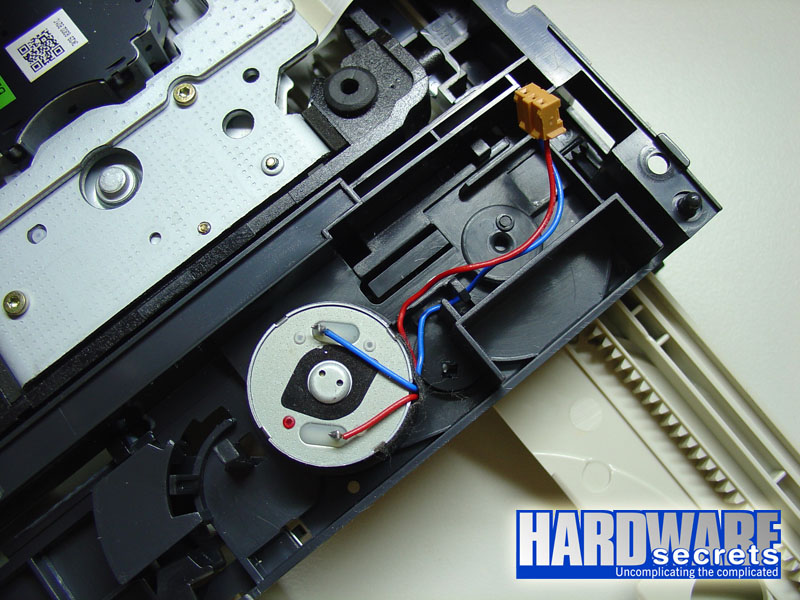 Figure 21: Tray motor, back view.
Figure 21: Tray motor, back view.
[nextpage title=”Optical Pickup Unit”]
The optical pickup unit has several components inside. First, lets take an overall look at this unit.
 Figure 22: Optical pickup unit.
Figure 22: Optical pickup unit.
 Figure 23: Optical pickup unit, back view. The arrows indicate the adjustment trimpots.
Figure 23: Optical pickup unit, back view. The arrows indicate the adjustment trimpots.
The optical pickup unit can be adjusted through trimpots located on its back. These trimpots regulate the laser power. Sometimes you can fix an optical drive that isn’t reading discs or is having a lot of reading errors by adjusting these trimpots. We will write a tutorial on how to adjust the laser optical unit in the future.
Let’s take a look at the main lens. This lens is also known as objective lens and has two coils attached to it. This set is installed between two magnets. So, depending on the current direction applied to the coils the lens can move up or down, as the intensity of the current will tell how much it will move. So these coils controls the lens focus.
There are two other coils called tracking coils (below the plastic part in Figure 24) that control the lateral movement of the lens. Thru these coils the system can place the lens in the correct position.
[nextpage title=”Optical Pickup Unit (Cont’d)”]
On Figures 25 and 26 you can see inside the optical pickup unit.
 Figure 25: Inside the optical pickup unit.
Figure 25: Inside the optical pickup unit.
 Figure 26: Main electrical components.
Figure 26: Main electrical components.
[nextpage title=”Logic Board”]
On the logic board you will find all circuitry in charge of controlling the optical drive. You will find components on both sides of the logic board. We picture in Figure 23 the side you see when you first open the drive, which is the solder side.
 Figure 27: Logic board main components, solder side.
Figure 27: Logic board main components, solder side.
In Figure 28 you see the components side of the logic board.
 Figure 28: Logic board main components, components side.
Figure 28: Logic board main components, components side.
The controller doesn’t drive enough current to turn on or move the optical drive motors. So all optical drives use a motor driver chip. This chip is a current amplifier. It takes the commands sent from the controller to the motors and passes them to the motors, but with a higher current. So, this chip is located between the controller and the motors.
The Flash-ROM circuit is where the optical drive firmware is located. Firmware is the name given to a program that is stored inside a ROM (Read Only Memory). The hard drive firmware is the program its controller executes.
There are two RAM chips in this unit, one with a very small capacity (128 KB) used by the controller which we labeled as “RAM” in Figure 28, and another one to store temporary data to be transferred to the computer, also known as buffer. The higher its capacity, the less vulnerable to the infamous “buffer underrun” error while recording CDs and DVDs your unit will be. Actually this error means that the buffer chip was empty. The larger the buffer, the lower the probability of buffer underruns.
You can find out the capacity of your optical drive buffer on the chip manufacturer’s website. For example, the memory chip in Figure 28 is a Hynix HY57V161610DTC chip. Going to Hynix’s website at https://hynix.com/datasheet/eng/dram/details/dram_01_HY57V161610DTC.jsp you can find this is a 16 Mb (Megabit) chip. The capacity of memory chips is given in Megabits, while we use Megabyte to refer to memory capacity. Thus we need to divide the value given in Megabit by eight in order to have the value in Megabyte. So, this chip is a 2 MB (Megabyte) chip, so this drive buffer is of 2 MB.
Usually to find out a chip function we just type in the numbers located on the first line of the chip package on Google and it will return a lot of information about the chip. But with our DVD burner we could find only information regarding the main processor chip, manufactured by NEC. The other chips, which were manufactured by Hitachi, we had to “guess” their functions, since we couldn’t find any explanation or datasheet about them on the web.
This “guess” however is not so complicated. First, the motor driver chip usually has a heatsink attached to it, so this one was easy to point out. Since all optical drives need a laser power controller (also known as RF chip), we just followed the wires from the optical pickup unit connector and found out that they were mainly connected to one chip, so we assumed that was the RF chip.
Since we were able to get the NEC processor (actually, a microcontroller) datasheet and we could see that this is a general-purpose processor, we assumed that the other big chip is the specific controller that “knows” how to control an optical unit. So we labeled it as “DVD+RW controller”.
If you’d like to learn even more about optical drives, we suggest you to take a look at the websites under https://www.repairfaq.org. That’s a terrific place to learn more about CD and DVD technologies and repair and laser technologies.



Leave a Reply